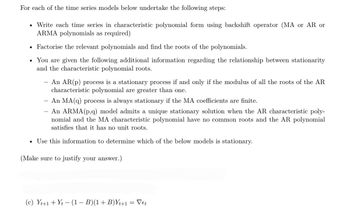
MATLAB: An Introduction with Applications
6th Edition
ISBN: 9781119256830
Author: Amos Gilat
Publisher: John Wiley & Sons Inc
expand_more
expand_more
format_list_bulleted
Question

Transcribed Image Text:For each of the time series models below undertake the following steps:
Write each time series in characteristic polynomial form using backshift operator (MA or AR or
ARMA polynomials as required)
• Factorise the relevant polynomials and find the roots of the polynomials.
• You are given the following additional information regarding the relationship between stationarity
and the characteristic polynomial roots.
●
An AR(p) process is a stationary process if and only if the modulus of all the roots of the AR
characteristic polynomial are greater than one.
- An MA(q) process is always stationary if the MA coefficients are finite.
An ARMA (p,q) model admits a unique stationary solution when the AR characteristic poly-
nomial and the MA characteristic polynomial have no common roots and the AR polynomial
satisfies that it has no unit roots.
• Use this information to determine which of the below models is stationary.
(Make sure to justify your answer.)
(c) Yt+1+ Yt - (1 − B)(1 + B)Yt+1 = Vet
Expert Solution
This question has been solved!
Explore an expertly crafted, step-by-step solution for a thorough understanding of key concepts.
This is a popular solution
Trending nowThis is a popular solution!
Step by stepSolved in 2 steps

Knowledge Booster
Similar questions
- For each of the time series models below undertake the following steps: Write each time series in characteristic polynomial form using backshift operator (MA or AR or ARMA polynomials as required) Factorise the relevant polynomials and find the roots of the polynomials. • You are given the following additional information regarding the relationship between stationarity and the characteristic polynomial roots. ● ● An AR(p) process is a stationary process if and only if the modulus of all the roots of the AR characteristic polynomial are greater than one. An MA(q) process is always stationary if the MA coefficients are finite. An ARMA (p,q) model admits a unique stationary solution when the AR characteristic poly- nomial and the MA characteristic polynomial have no common roots and the AR polynomial satisfies that it has no unit roots. ● Use this information to determine which of the below models is stationary. (Make sure to justify your answer.) (e) Let {Y} be a stationary process with…arrow_forwardFor each of the time series models below undertake the following steps: • Write each time series in characteristic polynomial form using backshift operator (MA or AR or ARMA polynomials as required) • Factorise the relevant polynomials and find the roots of the polynomials. • You are given the following additional information regarding the relationship between stationarity and the characteristic polynomial roots. An AR(p) process is a stationary process if and only if the modulus of all the roots of the AR characteristic polynomial are greater than one. An MA(q) process is always stationary if the MA coefficients are finite. An ARMA (p,q) model admits a unique stationary solution when the AR characteristic poly- nomial and the MA characteristic polynomial have no common roots and the AR polynomial satisfies that it has no unit roots. Use this information to determine which of the below models is stationary. (Make sure to justify your answer.) (a) VY + ²3 (Yt + 5Y₁-1) = € - €t-1 − −2+ 3…arrow_forwardAn engineer designs a circuit, seen below. In this system, if the first component fails, the functionality moves immediately to the second component and so on. The system only fails when the fifth component fails. Each component has a lifetime that is exponentially distributed with λ = 0.01 and components fail independently of one another. Define A, to be the length of time component i lasts. Let Y = the time at which the new system fails. Given 2 لنا 5 A-Exponential (0.01) Y=A1+A2+A3+A4+A5 1. Find the probability that this new system will last fewer than 50 hours.arrow_forward
arrow_back_ios
arrow_forward_ios
Recommended textbooks for you
 MATLAB: An Introduction with ApplicationsStatisticsISBN:9781119256830Author:Amos GilatPublisher:John Wiley & Sons Inc
MATLAB: An Introduction with ApplicationsStatisticsISBN:9781119256830Author:Amos GilatPublisher:John Wiley & Sons Inc Probability and Statistics for Engineering and th...StatisticsISBN:9781305251809Author:Jay L. DevorePublisher:Cengage Learning
Probability and Statistics for Engineering and th...StatisticsISBN:9781305251809Author:Jay L. DevorePublisher:Cengage Learning Statistics for The Behavioral Sciences (MindTap C...StatisticsISBN:9781305504912Author:Frederick J Gravetter, Larry B. WallnauPublisher:Cengage Learning
Statistics for The Behavioral Sciences (MindTap C...StatisticsISBN:9781305504912Author:Frederick J Gravetter, Larry B. WallnauPublisher:Cengage Learning Elementary Statistics: Picturing the World (7th E...StatisticsISBN:9780134683416Author:Ron Larson, Betsy FarberPublisher:PEARSON
Elementary Statistics: Picturing the World (7th E...StatisticsISBN:9780134683416Author:Ron Larson, Betsy FarberPublisher:PEARSON The Basic Practice of StatisticsStatisticsISBN:9781319042578Author:David S. Moore, William I. Notz, Michael A. FlignerPublisher:W. H. Freeman
The Basic Practice of StatisticsStatisticsISBN:9781319042578Author:David S. Moore, William I. Notz, Michael A. FlignerPublisher:W. H. Freeman Introduction to the Practice of StatisticsStatisticsISBN:9781319013387Author:David S. Moore, George P. McCabe, Bruce A. CraigPublisher:W. H. Freeman
Introduction to the Practice of StatisticsStatisticsISBN:9781319013387Author:David S. Moore, George P. McCabe, Bruce A. CraigPublisher:W. H. Freeman

MATLAB: An Introduction with Applications
Statistics
ISBN:9781119256830
Author:Amos Gilat
Publisher:John Wiley & Sons Inc

Probability and Statistics for Engineering and th...
Statistics
ISBN:9781305251809
Author:Jay L. Devore
Publisher:Cengage Learning

Statistics for The Behavioral Sciences (MindTap C...
Statistics
ISBN:9781305504912
Author:Frederick J Gravetter, Larry B. Wallnau
Publisher:Cengage Learning

Elementary Statistics: Picturing the World (7th E...
Statistics
ISBN:9780134683416
Author:Ron Larson, Betsy Farber
Publisher:PEARSON

The Basic Practice of Statistics
Statistics
ISBN:9781319042578
Author:David S. Moore, William I. Notz, Michael A. Fligner
Publisher:W. H. Freeman

Introduction to the Practice of Statistics
Statistics
ISBN:9781319013387
Author:David S. Moore, George P. McCabe, Bruce A. Craig
Publisher:W. H. Freeman